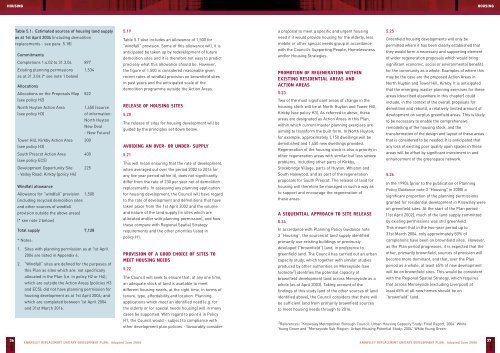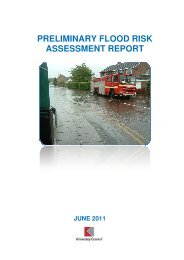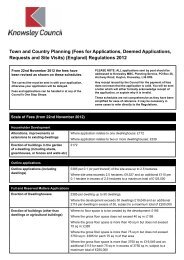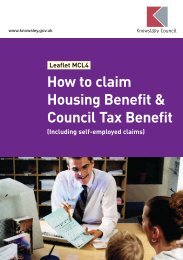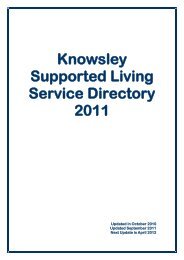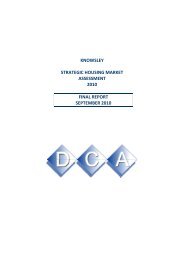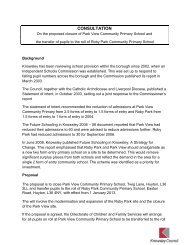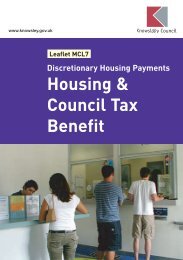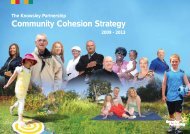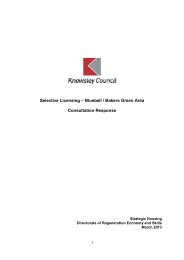Knowsley Replacement Unitary Development Plan - Knowsley Council
Knowsley Replacement Unitary Development Plan - Knowsley Council
Knowsley Replacement Unitary Development Plan - Knowsley Council
You also want an ePaper? Increase the reach of your titles
YUMPU automatically turns print PDFs into web optimized ePapers that Google loves.
HOUSING<br />
HOUSING<br />
Table 5.1: Estimated sources of housing land supply<br />
as at 1st April 2004 (including demolition<br />
replacements - see para. 5.18)<br />
Commitments<br />
Completions 1.4.02 to 31.3.04 897<br />
Existing planning permissions 1,534<br />
as at 31.3.04 (* see note 1 below)<br />
Allocations<br />
Allocations on the Proposals Map 822<br />
(see policy H2)<br />
North Huyton Action Area 1,450 (source<br />
(see policy H3)<br />
of information:<br />
North Huyton<br />
New Deal<br />
- New Future)<br />
Tower Hill, Kirkby Action Area 300<br />
(see policy H3)<br />
South Prescot Action Area 400<br />
(see policy EC5)<br />
<strong>Development</strong> Opportunity Site 225<br />
- Valley Road, Kirkby (policy H4)<br />
Windfall allowance<br />
Allowance for “windfall” provision 1,500<br />
(including recycled demolition sites<br />
and other sources of windfall<br />
provision outside the above areas)<br />
(* see note 2 below)<br />
Total supply 7,128<br />
* Notes:<br />
1. Sites with planning permission as at 1st April<br />
2004 are listed in Appendix 4.<br />
2. "Windfall” sites are defined for the purposes of<br />
this <strong>Plan</strong> as sites which are: not specifically<br />
allocated in the <strong>Plan</strong> (i.e. in policy H2 or H4);<br />
which are outside the Action Areas (policies H3<br />
and EC5); did not have planning permission for<br />
housing development as at 1st April 2004; and<br />
which are completed between 1st April 2004<br />
and 31st March 2016.<br />
5.19<br />
Table 5.1 also includes an allowance of 1,500 for<br />
"windfall" provision. Some of this allowance will, it is<br />
anticipated be taken up by redevelopment of future<br />
demolition sites and it is therefore not easy to predict<br />
precisely what this allowance should be. However,<br />
the figure of 1,500 is considered reasonable given<br />
recent rates of windfall provision on brownfield sites<br />
in past years and the anticipated scale of the<br />
demolition programme outside the Action Areas.<br />
RELEASE OF HOUSING SITES<br />
5.20<br />
The release of sites for housing development will be<br />
guided by the principles set down below.<br />
AVOIDING AN OVER- OR UNDER- SUPPLY<br />
5.21<br />
This will mean ensuring that the rate of development,<br />
when averaged out over the period 2002 to 2016 (or<br />
any five year period within it), does not significantly<br />
differ from the rate of 230 per year net of demolition<br />
replacements. In assessing any planning application<br />
for housing development, the <strong>Council</strong> will have regard<br />
to the rate of development and demolitions that have<br />
taken place from the 1st April 2002 and the volume<br />
and nature of the land supply (in sites which are<br />
allocated and/or with planning permission), and how<br />
these compare with Regional Spatial Strategy<br />
requirements and the other priorities listed in<br />
policy H1.<br />
PROVISION OF A GOOD CHOICE OF SITES TO<br />
MEET HOUSING NEEDS<br />
5.22<br />
The <strong>Council</strong> will seek to ensure that, at any one time,<br />
an adequate stock of land is available to meet<br />
different housing needs, at the right time, in terms of<br />
tenure, type, affordability and location. <strong>Plan</strong>ning<br />
applications which meet an identified need (e.g. for<br />
the elderly or for special needs housing) will in many<br />
cases be supported. With regard to point 4 in Policy<br />
H1, the <strong>Council</strong> would - subject to compliance with<br />
other development plan policies - favourably consider<br />
a proposal to meet a specific and urgent housing<br />
need if it would provide housing for the elderly, less<br />
mobile or other special needs group in accordance<br />
with the <strong>Council</strong>’s Supporting People, Homelessness<br />
and/or Housing Strategies.<br />
PROMOTION OF REGENERATION WITHIN<br />
EXISTING RESIDENTIAL AREAS AND<br />
ACTION AREAS<br />
5.23<br />
Two of the most significant areas of change in the<br />
housing stock will be at North Huyton and Tower Hill,<br />
Kirkby (see policy H3). As referred to above, these<br />
areas are designated as Action Areas in this <strong>Plan</strong>,<br />
within which current master planning exercises are<br />
aiming to transform the built form. In North Huyton,<br />
for example, approximately 1,150 dwellings will be<br />
demolished and 1,450 new dwellings provided.<br />
Regeneration of the housing stock is also a priority in<br />
other regeneration areas with similar but less severe<br />
problems, including other parts of Kirkby,<br />
Stockbridge Village, parts of Huyton, Whiston and<br />
South Halewood, and as part of the regeneration<br />
proposals for South Prescot. The release of land for<br />
housing will therefore be managed in such a way as<br />
to support and encourage the regeneration of<br />
these areas.<br />
A SEQUENTIAL APPROACH TO SITE RELEASE<br />
5.24<br />
In accordance with <strong>Plan</strong>ning Policy Guidance note<br />
3 “Housing”, the sources of land supply identified<br />
primarily use existing buildings or previously<br />
developed (“brownfield”) land, in preference to<br />
greenfield land. The <strong>Council</strong> has carried out an urban<br />
capacity study, which together with similar studies<br />
produced by other authorities on Merseyside (see<br />
footnote 2 ) identifies the potential capacity of<br />
brownfield development land across Merseyside as a<br />
whole (as at April 2003). Taking account of the<br />
findings of this study (and of the other sources of land<br />
identified above), the <strong>Council</strong> considers that there will<br />
be sufficient land from primarily brownfield sources<br />
to meet housing needs through to 2016.<br />
5.25<br />
Greenfield housing developments will only be<br />
permitted where it has been clearly established that<br />
they would form a necessary and supporting element<br />
of wider regeneration proposals which would bring<br />
significant economic, social or environmental benefits<br />
for the community as a whole. Examples of where this<br />
may be the case are the proposed Action Areas in<br />
North Huyton and Tower Hill, Kirkby. It is anticipated<br />
that the emerging master planning exercises for these<br />
areas (described elsewhere in this chapter) could<br />
include, in the context of the overall proposals for<br />
demolition and rebuild, a relatively limited amount of<br />
development on surplus greenfield areas. This is likely<br />
to be necessary to enable the comprehensive<br />
remodelling of the housing stock, and the<br />
transformation of the design and layout of these areas<br />
that is considered to be needed. It is anticipated that<br />
any loss of existing poor quality open spaces in these<br />
areas will be offset by significant investment in and<br />
enhancement of the greenspace network.<br />
5.26<br />
In the 1990s (prior to the publication of <strong>Plan</strong>ning<br />
Policy Guidance note 3 "Housing" in 2000) a<br />
significant proportion of the planning permissions<br />
granted for residential development in <strong>Knowsley</strong> were<br />
on greenfield sites. At the start of the <strong>Plan</strong> period<br />
(1st April 2002), much of the land supply committed<br />
by existing permissions was still greenfield.<br />
This meant that in the two-year period up to<br />
31st March 2004, only approximately 50% of<br />
completions have been on brownfield sites. However,<br />
as the <strong>Plan</strong> period progresses, it is expected that the<br />
other, primarily brownfield, sources of provision will<br />
become more dominant, and that, over the <strong>Plan</strong><br />
period as a whole, at least 65% of new development<br />
will be on brownfield sites. This would be consistent<br />
with the Regional Spatial Strategy, which requires<br />
that across Merseyside (excluding Liverpool) at<br />
least 65% of all new homes should be on<br />
“brownfield” land.<br />
2 References: “<strong>Knowsley</strong> Metropolitan Borough <strong>Council</strong>: Urban Housing Capacity Study: Final Report, 2004” White<br />
Young Green and “Merseyside Sub-Region: Urban Housing Potential Study: 2004” White Young Green<br />
36<br />
KNOWSLEY REPLACEMENT UNITARY DEVELOPMENT PLAN: Adopted June 2006<br />
KNOWSLEY REPLACEMENT UNITARY DEVELOPMENT PLAN: Adopted June 2006<br />
37


